-

人教版新目标初中英语八年级上册What’s the matter教案2篇
She shouldn’t go to the party tonight.Step7. TaskT: You know, there are lots of problems in our life. If you are a doctor, please tell us how to solve the problem. I will divide you into 9 groups. Please work in groups. And then choose one of you to report your ideas.The following are the problems:I have a toothache.I am hungry. I have a sore throat.I am stressed out. I have a sore back.I am tired. I can’t sleep.I have a cold. I have a headache.Report: If you have a headache, you should go to bed early. You should see the doctor. You should eat some medicine. You shouldn’t wash your face with cold water.You shouldn’t sleep late.You shouldn’t swim.…..T encourages the students to give advice as much as possible.Homework:1. Chose one of the problems, and write down your advice2. Copy the new words这一步是用于热身的,同时也可以让他们复习一部分的表示人体部位的单词,扩充知识.学习语言的过程也是一个不断积累的过程,复习旧知识,增添新知识.通过小游戏,强化学生对Does she/he have…这个句子的运用能力.通过复习,自然的引到下面新知识的学习。充分利用表格,由句子到对话,再到文章,让学生循序渐进. 提高学生的综合语言运用能力,运用以前学过的知识来解决身边的问题.Period 5 (Section B 3a—3c, selfcheck)教学内容与分析:

人教版新目标初中英语九年级上册Teenagers should be allowed to choose their own clothes教案2篇
Step 1 Greeting Greet the class and check the homeworkStep 2 A duty report The S on duty gives a report on the rules in his home and lead in 3a “Sun Fei’s and Wu Yu’s rules” Step 3 ReadingSs read the conversation and write the two girls’ rules in the chart. Check the answers.Get Ss to read after the tape and then read aloud by themselves. Then, T explains the language points.Step 4 Pairwork 3bRole play. Use the information in chart to practice with the conversation in 3a covered. They can look at the sample conversation in the right box.Step 5 Task 2 “Who’s the best reporter?”Make a survey by asking any 5 students the questions in the chart in activity 4. Then give out a report about it. See who is the best reporter? And the best reporter will get a nice ball-pen.Step 6 Summary and homework:Write out the report in your exercise-books.Period ThreeStep 1 Greeting and a duty reportThe S gives a duty report talking about his experience of being late for school. Lead in the question “Do you ever get to school late? How often do you get to school late? Always, usually, sometimes, or never?Step 2 1a Get Ss to finish writing.Step 3 Pairwork 1b Get Ss to talk about their answers with their partners using the sample conversation in the box on the right.Step 4 Listening practice2a Lead-in: What will happen if you get to school late? What about Peter? Let’s listen to a conversation between Peter and his father. Get Ss to finish 2a (As usual, for the first time, Ss only listen.) Check the answers.

人教版新目标初中英语九年级上册I used to be afraid of the dark教案
内容提示1.本单元主要内容是学会used to结构。Used to +动词原形表示过去经常、以前常常,只用于过去式中,用来表示现在已不存在的习惯或状态。例如:They used to play football together.他们过去常在一起蹋足球。(现在不在一起踢了)2.used to的疑问形式和否定形式为Did you use to…?和I didn’t use to… 也可以用Used you to…?和I used not to…但现在多使用前者。例如:Did you used to swim in the river? 你过去常在河里游泳吗?I didn’t use to play the piano. 我以前并不经常弹钢琴。教学目标一、学习目标(Language Goal) 1.学会陈述自己过去常做的事情。2.学会陈述自己过去的爱好等。3.能够表达自己现在和过去在外表、性格、娱乐等方面的变化。4.能够表达朋友、家人等现在和过去的变化。二、语言结构(Language Structures) 1.I used to be short when I was young. 我年轻时个子很矮。 2. —Did you use to have straight hair? 你过去是直发吗?—Yes, I did. 是的。 3. —Did you use to play the piano? 你过去弹钢琴吗?—No, I didn’t. 不,我不弹。 4.I used to be afraid of dark. 我过去害怕黑暗。 5.I’m terrified of the snakes. 我害怕蛇。

人教版新目标初中英语九年级上册It must belong to Carla教案
一、Section A该部分有4个模块。第一模块围绕Whose volleyball is this? 这一话题展开思维( 1a)、听力(1b)、口语( 1c)训练;第二模块围绕上一模块中的话题进行听力( 2a-2b)、口语训练( 2c);第三模块继续围绕前两个模块中的“making inferences”展开训练。训练形式为阅读排序( 3a)和两人问答(3b);第四模块仍就上一话题展开讨论。二、Section B该部分有4个模块。第一模块要求根据图画和所提供的单词写出合理的句子;第二模块在听力( 2a-2b)和分角色口语训练( 2c)的基础上,继续进行“推测”训练; 第三模块围绕“Strange events in Bell Tower neighborhood”这一话题展开阅读( 3a)和写作(3b -3c)训练;第四模块以dream为话题展开小组活动。三、Self Check该部分有3个模块。第一模块以填空形式对所学词汇进行训练;第二模块就8个谚语展开阅读和讨论。

人教版新目标初中英语八年级上册Could you please clean your room教案3篇
一、 教学内容Section A 1a----1c二、 教学目标1.学习词汇do the dishes, make the bed, take out the trash, fold the clothes, do the laundry, sweep the floor, clean the living room.2.句型 Could you please clean your room? Yes, sure.三、 教学准备 学生预习本单元所有的词汇多媒体课件 活动表 奖品四、 教学过程Pre-task1. Warming upEnjoy ourselves. Watch cartoon Cinderella. 看动画片段《灰姑娘》导如入本课话题和新词汇“chores”美丽善良的鬼姑娘因继母的嫉妒,每天得做所有的家务。片段的主题使学生联想到本课的话题。2. learn new words and phrasesLook! What is she / he dong? 看图学习动词词组do chores, do the dishes, make the bed, take out the trash, fold the clothes, do the laundry, clean the living room.3. Guessing game.What is she doing ? 4. Pair work. 1a, Do you do these things at home? Write “Y” for “yes” and “N” for “no”.5. Listening . 1b , Peter’s chores or Mom’s chores?理解目标语Could you please clean your room? Yes, sure.Write “M” for Mom’s chores, “P” for Peter’s chores in the chart.6. PairworkLook at the picture,Ask your partner to do the chores that you see. 7. Interview Who is the most able at home? 1) What chores do you do at home? How often do you do the chores? Work in four, interview each of the students in the group, fill in the chart.

人教版新目标初中英语八年级上册What are you doing for vacation教案2篇
Teaching goals : 1. Words & phrases: babysit ,get back , fishing , rent , think about , decide(on) , tourist etc. 2. How to talk about future plans . 3. 现在进行时表示将来计划或行动. 4. 特殊疑问句(where , when , how long引导) Important and difficult points : Drills :What are you doing for vacation ? I’m watching TV . When are you going ? I’m going … . How long are you staying ? We’re staying for five days . Teaching aids : cards and a tape ,a large wall calendar . Period 1 Teaching procedures : Step 1Leading in1. Free talk . 2. Put up the wall calendar . T: I’m staying home on Saturday (pointing to next Saturday ).Ss repeat . Ss: I’m staying home on Saturday . T: OK. Today we’ll learn how to talk about future plans. Step 2Pre-task SB Page 13 , 1a . 1. Look at the picture carefully and tell what you see in the picture . 2. Write the activities from the pictures in the box and add some more . 3. Practice reading . Step 3While-task1. Using the activities we write in 1a to make conversations .For example :What are you doing for vacation ? I’m visiting my uncle . 2. Pairwork .Practice in pairs . 3. 用第三人称练习对话.

人教版新目标初中英语八年级上册What’s the best radio station教案2篇
教学重点和难点:运用所掌握的语言描述,比较不同地点的特点。在练习中学习掌握英语比较级和最高级的用法。课前准备分配小组,每组五至六人。通过上网或翻阅报刊杂志等方法,确定旅游线路,做出基本的旅游计划。教学设计:本节课流程图 学法指导:1.由于这是一堂新课,在教学中应注意面向全体,发挥学生的主体性,引导学生积极参与,激发学生的求知欲和学习积极性,指导学生积极思维,主动获取知识,养成良好的学习方法。逐步学会独立解决问题。总之要尽可能调动学生的非智力因素促进智力因素的发展。教法选择:1.电化教学法2.课堂讨论法3.任务型教学法采用这些方法的目的是为了充分调动学生的学习积极性,使学生变被动学习为主动学习。通过电脑形象的演示,加强印象,提高兴趣,突破难点,提高教学效率,进而增大教学的容量和信息量。充分体现教师为主导,学生为主体的教学原则。

人教版新目标初中英语九年级上册I like music that I can dance to教案
教学目标: 1. Express preferences2. Talk about one’s likes and dislikes and the reasons3. Learn to express one’s opinions 4. Learn to write a reply 语言功能: 1) Talk about one’s preferences, using t he relative clause2) Talk about people’s likes and dislikes and the reasons3) Talk about opinions语言结构: Relative clauses with that and who语言目标:What kind of music do you like?I like music that I can sing along with.I love singers who write their own music.We prefer music that has great lyric.重点词汇及短语:heart, photography, interest, class, whatever, miss, okay, expect, sweet, taste, itself, laboratory, cancer, increase, biscuit, main, care, prefer… to…, remind somebody of …, dance to, sing along with, be sure to, interest somebody, make somebody adj., to be honest, suit somebody, on display, catch up教学重难点:What do other people think of the different kinds of things? How to express one’s opinions? 学习方式:讨论,合作学习情感目标:通过本单元的学习,能提高学生的艺术鉴赏能力和审美情趣,并引导学生养成健康的饮食习惯。课时安排5课时第一课时:Section A: 1a-2c第二课时:Section A : 3a-4第三课时:Section B:1-2c, Self check2第四课时:Section B: 3a-4, Self check1第五课时:Self check ReadingI like music that I can dance to.

人教版新目标初中英语九年级上册How do you study for a test教案2篇
内容提示本单元主要内容是学会利用verb十by/with gerund表示方式方法来讨论学习英语的策略,认识自己在学习方面的长处和不足。初步了解现在完成时的结构和用法。现在完成时由助动词have/has+动词的过去分词构成,主要表示过去发生的某一动作对现在仍有影响或造成的后果,常与already,yet,just,ever,never等副词连用。教学目标一、学习目标(Language Goal) 1. Talk about how to study . 学会讨论各种学习方法和策略。2. Find out your suitable learning methods. 找出适合自己的学习方法。 二、语言结构(Language Structures) 1. Verb + by with gerund by+动名词短语 表示“通过…途径,方法” 2. How questions have引导的特殊疑问句 三、目标语言(Target Language) 1. How do you study for tests ? 你是怎样准备考试的?Well , I study by working with my classmates. 哦,我和同学们一起学习。2. Have you ever studied with a group ? 你曾经参加过学习小组吗?Yes , I have . I’ve learned a lot that way . 是的,参加过。通过这种方式我学了许多。

人教版新目标初中英语九年级上册Where would you like to visit教案2篇
The First PeriodⅠ.Teaching Aims and DemandsKnowledge Objects(1) Key Vocabularytiring, educational, fascinating, thrilling, peaceful, exotic, trek, jungle, take it easy, explore, historic, site(2) Target LanguageWhere would you like to go on vacation?I’d like to trek through the jungle, because I like exciting vacations.2. Ability Objects(1)Train students to talk about places they would like to visit with the target language.(2)Train students to describe vacations with different adjectives.(3)Train students' listening skill.3. Moral Object,It′s more interesting to go on vacating somewhere instead of staying at home.Ⅱ. Teaching Key Points1. Key Vocabularytiring, educational, fascinating, thrilling, peaceful, exotic, trek, jungle, take it easy, explore, historic, site2. Target LanguageTalk about different places with the target language.Ⅲ. Teaching Difficult Points1. Describe vacations with different adjectives.2. Talk about different places with the target language.Ⅳ. Teaching Methods1. Teaching by illumination2. Teaching by doing chain drills3. Teaching by pairworkⅤ. Teaching Aids1. A tape recorder2. Some pictures of different places with famous views
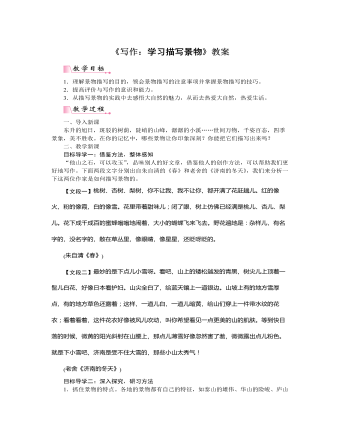
部编版语文八年级上册《写作:学习描写景物》教案
5.发挥想象。两段文字都运用了想象的手法。“闭了眼,树上仿佛已经满是桃儿、杏儿、梨儿”“看着看着,这件花衣好像被风儿吹动,叫你希望看见一点更美的山的肌肤”“那点儿薄雪好像忽然害了羞”,这些想象,既突出了景物的特点,又融入了作者的情感,可谓是一举两得。6.讲究描写的顺序。两段文字都采用空间顺序展开描写,景物的层次清晰。要注意观察的顺序,是由近及远,还是由远及近?是由上到下,还是由下到上?这是指空间的变换。还可以以时间的变化或游览的先后为顺序。这样,所描写的景物才不会杂乱无章。7.写景还要融入情感。“一切景语皆情语”。写景贵有情,在描绘客观景物的同时,要把自己的喜怒哀乐等思想感情融注到作品中去,使读者产生共鸣,进而给读者带来愉悦之情、陶醉之情,将读者带入特定的情景之中,受到美的熏陶,获得美的享受。如《从百草园到三味书屋》中“夏天百草园”一段“油蛉在这里低唱,蟋蟀们在这里弹琴”,在作者小时候听来,油蛉、蟋蟀的叫声犹如人在悠扬的琴声伴奏下婉转地低唱,其间传递着作者愉快、喜悦的心声,表达作者对大自然的喜爱和向往之情。目标导学三:实战演练描写你家乡一处有特色的景物,包括自然景物和社会景物,要求描写细致、生动,表达你对家乡的热爱之情。例文展示:
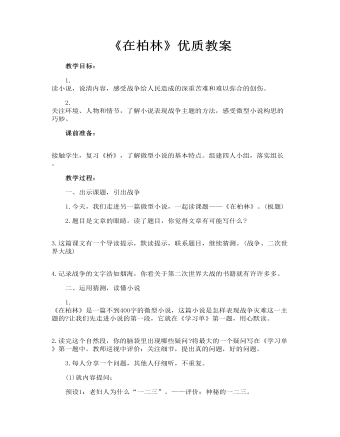
《在柏林》优质教案
一、出示课题,引出战争 1.今天,我们走进另一篇微型小说,一起读课题——《在柏林》。(板题) 2.题目是文章的眼睛。读了题目,你觉得文章有可能写什么? 3.这篇课文有一个导读提示,默读提示,联系题目,继续猜测。(战争、二次世界大战) 4.记录战争的文字浩如烟海,你看关于第二次世界大战的书籍就有许许多多。
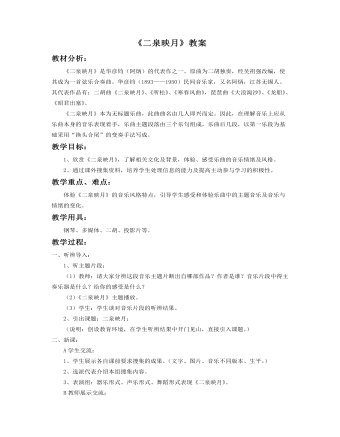
《二泉映月》教案
教材分析: 《二泉映月》是华彦钧(阿炳)的代表作之一。原曲为二胡独奏,经吴祖强改编,使其成为一首弦乐合奏曲。华彦钧(1893——1950)民间音乐家,又名阿炳,江苏无锡人。其代表作品有:二胡曲《二泉映月》、《听松》、《寒春风曲》,琵琶曲《大浪淘沙》、《龙船》、《昭君出塞》。 《二泉映月》本为无标题乐曲,此曲曲名由几人即兴而定。因此,在理解音乐上应从乐曲本身的音乐表现着手,乐曲主题段落由三个乐句组成,乐曲后几段,以第一乐段为基础采用“换头合尾”的变奏手法写成。教学目标: 1、欣赏《二泉映月》,了解相关文化及背景,体验、感受乐曲的音乐情绪及风格。 2、通过课外搜集资料,培养学生处理信息的能力及提高主动参与学习的积极性。
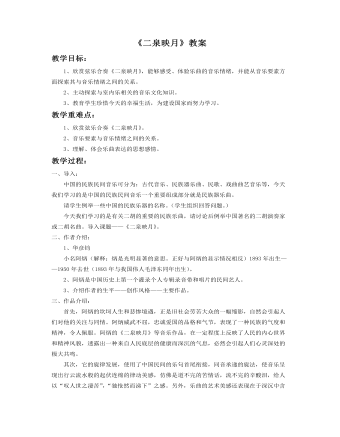
《二泉映月》教案
首先,阿炳的坎坷人生和悲惨境遇,正是旧社会劳苦大众的一幅缩影,自然会引起人们对他的关注与同情。阿炳威武不屈,忠诚爱国的品格和气节,表现了一种民族的气度和精神,令人佩服。阿炳的《二泉映月》等音乐作品,在一定程度上反映了人民的内心世界和精神风貌,透露出一种来自人民底层的健康而深沉的气息,必然会引起人们心灵深处的极大共鸣。 其次,它的旋律发展,使用了中国民间的乐句首尾衔接,同音承递的旋法,使音乐呈现出行云流水般的起伏连绵的律动美感,仿佛是道不完的苦情话,流不完的辛酸泪,给人以“叹人世之凄苦”,“独怆然而涕下”之感。另外,乐曲的艺术美感还表现在于深沉中含质朴,感伤中见苍劲,刚柔并济,动人心魄。再则,这首乐曲体现了注重情深、着意传神的法则,发人联想,令人回味。
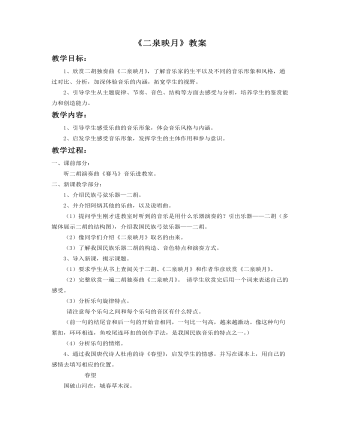
《二泉映月》教案
教学过程:一、课前部分: 听二胡演奏曲《赛马》音乐进教室。二、新课教学部分: 1、介绍民族弓弦乐器—二胡。 2、并介绍阿炳其他的乐曲,以及说唱曲。 (1)提问学生刚才进教室时听到的音乐是用什么乐器演奏的?引出乐器——二胡(多媒体展示二胡的结构图),介绍我国民族弓弦乐器——二胡。 (2)像同学们介绍《二泉映月》取名的由来。 (3)了解我国民族乐器二胡的构造、音色特点和演奏方式。 3、导入新课,揭示课题。 (1)要求学生从书上查阅关于二胡、《二泉映月》和作者华彦欣赏《二泉映月》。 (2)完整欣赏一遍二胡独奏曲《二泉映月》。 请学生欣赏完后用一个词来表述自己的感受。
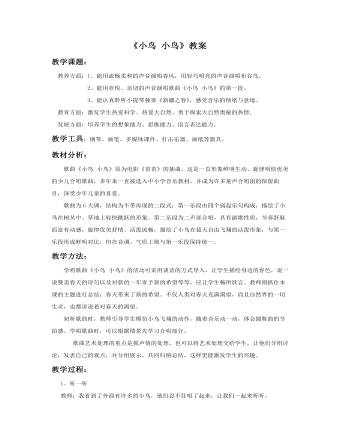
《小鸟 小鸟》教案
学唱歌曲《小鸟 小鸟》的活动可采用谈话的方式导入,让学生描绘身边的春色,说一说赞美春天的诗句以及对新的一年寄予新的希望等等,应让学生畅所欲言。教师则抓住本课的主题进行总结:春天带来了新的希望。不仅人类对春天充满渴望,而且自然界的一切生灵,也都诉说着对春天的渴望。 初听歌曲时,教师引导学生模仿小鸟飞翔的动作,随着音乐动一动,体会圆舞曲的节拍感。学唱歌曲时,可以根据情景先学习合唱部分。 歌曲艺术处理的重点是抓声情的处理。也可以将艺术处理交给学生,让他们分组讨论,发表自己的观点,并分组展示,共同归纳总结,这样更能激发学生的兴趣。

《小鸟 小鸟》教案
一、情境导入 出示几幅风景画,展示春天的景色,感受春天的美景。老师说:“小鸟非常的可爱,给我们的生活带来了无穷的乐趣,下面我们就来听一首歌曲《小鸟 小鸟》,听后请你们说说自己的感受。”二、寓教于乐 学生初听歌曲,感受歌曲情绪。学生表达自己的感受:欢跃、亲切地、活泼地…… 教师:这样一首欢快的歌曲你们想不想知道它唱得是什么内容呀?(学生回答)下面就请大家认真听一听歌曲中都唱了什么?学生听歌曲内容,听后复述:春天里有阳光,树林里有花香,小鸟在自由地飞翔,在田野,在草地,在湖边,在山岗,小鸟迎着春天歌唱…… 学生再次聆听歌曲,熟悉歌曲内容。
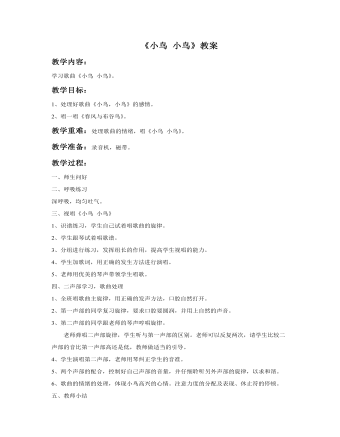
《小鸟 小鸟》教案
一、师生问好二、呼吸练习深呼吸,均匀吐气。三、视唱《小鸟小鸟》1、识谱练习,学生自己试着唱歌曲的旋律。2、学生跟琴试着唱歌谱。3、分组进行练习,发挥组长的作用,提高学生视唱的能力。4、学生加歌词,用正确的发生方法进行演唱。5、老师用优美的琴声带领学生唱歌。四、二声部学习,歌曲处理1、全班唱歌曲主旋律,用正确的发声方法,口腔自然打开。2、第一声部的同学复习旋律,要求口腔要圆润,并用上自然的声音。3、第二声部的同学跟老师的琴声哼唱旋律。老师弹唱二声部旋律,学生听与第一声部的区别。老师可以反复两次,请学生比较二声部的音比第一声部高还是低,教师做适当的引导。
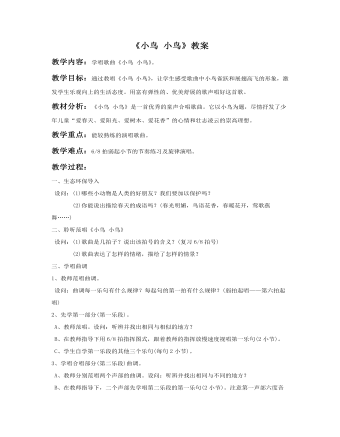
《小鸟 小鸟》教案
一、生态环保导入 设问:(1)哪些小动物是人类的好朋友?我们要加以保护吗? (2)你能说出描绘春天的成语吗?(春光明媚,鸟语花香,春暖花开,莺歌燕舞……)二、聆听范唱《小鸟 小鸟》 设问:(1)歌曲是几拍子?说出该拍号的含义?(复习6/8拍号) (2)歌曲表达了怎样的情绪,描绘了怎样的情景?三、学唱曲调1、教师范唱曲调。 设问:曲调每一乐句有什么规律?每起句的第一拍有什么规律?(弱拍起唱——第六拍起唱)2、先学第一部分(第一乐段)。 A、教师范唱。设问:听辨并找出相同与相似的地方?
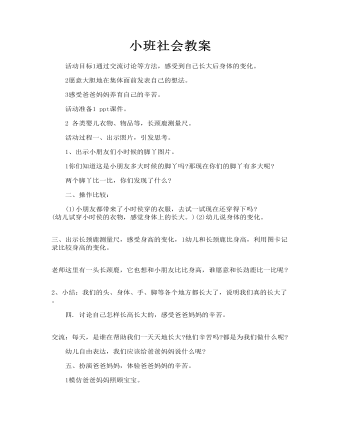
小班社会教案
(1)小朋友都带来了小时侯穿的衣服,去试一试现在还穿得下吗? (幼儿试穿小时侯的衣物,感觉身体上的长大。)(2)幼儿说身体的变化。 三、出示长颈鹿测量尺,感受身高的变化,1幼儿和长颈鹿比身高,利用图卡记录比较身高的变化。 老师这里有一头长颈鹿,它也想和小朋友比比身高,谁愿意和长劲鹿比一比呢? 2、小结:我们的头、身体、手、脚等各个地方都长大了,说明我们真的长大了。 四. 讨论自己怎样长高长大的,感受爸爸妈妈的辛苦。

